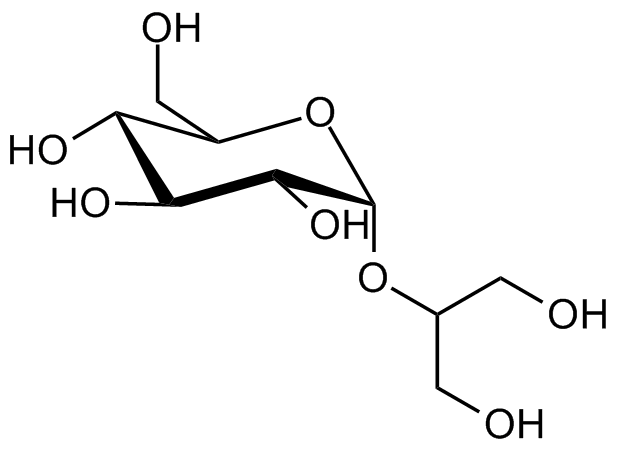Glucosylglycerol
Product Code: AG-CN2-0393
Product Group: Natural Products and Extracts
Supplier: AdipoGen Life Sciences
| Code | Size | Price |
|---|
| AG-CN2-0393-GT01 | 1000 g | Enquire |
Quantity:
| AG-CN2-0393-G001 | 1 g | £40.00 |
Quantity:
| AG-CN2-0393-G010 | 10 g | £147.00 |
Quantity:
| AG-CN2-0393-G100 | 100 g | £1,022.00 |
Quantity:
Prices exclude any Taxes / VAT
Overview
Regulatory Status: RUO
Shipping:
AMBIENT
Storage:
+20°C
Images
Documents
Further Information
Alternate Names/Synonyms:
Glucosyl glycerol; Glyceryl glucoside; alpha-D-Glucopyranoside; alpha-D-Glucosylglycerol; 2-O-(alpha-D-glucopyranosyl)-sn-glycerin; Glycoin
Appearance:
Slightly yellowish liquid.
CAS:
22160-26-5
EClass:
32160000
Endotoxin:
<5000EU/g
Form (Short):
liquid
Formulation:
50% w/w aqueous solution without proteins or preservatives.
Handling Advice:
Keep cool and dry.
InChi:
InChI=1S/C9H18O8/c10-1-4(2-11)16-9-8(15)7(14)6(13)5(3-12)17-9/h4-15H,1-3H2/t5-,6-,7+,8-,9+/m1/s1
InChiKey:
AQTKXCPRNZDOJU-ZEBDFXRSSA-N
Long Description:
Natural chemical product. CAS: 22160-26-5. Formula: C9H18O8. MW: 254.2. Enzymatically processed from natural succrose and glycerine. Glucosylglycerol belongs to the class of compatible solutes (osmolytes). It is a non-toxic, non-irritating protective osmolyte responsible for the osmotic adaptation of blue-green algae, rhizobacteria and Pseudomonas and also found in the drought-resistant 'resurrection plant' Myrothamnus flabellifolia. Glucosylglycerol protects its host against osmotic stress, heat, desiccation and UV. Glucosylglycerol is an animal free and protein-free low molecular weight stabilizer which is an excellent cryoprotector for proteins in vitro, especially antibodies. In vitro models and skin models demonstrate strong activity of glucosylglycerol on aged and stressed skin cells with rejuvenating, recovering and radical scavenging properties. In vivo treatments confirm positive effects on increased skin elasticity, smoothness and thickness, the epidermis and dermis density regenerate with no irritating effects. It is used as a multifunctional anti-aging, cell-stimulating and skin moisturizing agent in cosmetics. Glucosylglycerol is a 100% natural sugar derivative.
MDL:
MFCD19980985
Molecular Formula:
C9H18O8
Molecular Weight:
254.2
Package Type:
Vial
Product Description:
Glucosylglycerol belongs to the class of compatible solutes (osmolytes). It is a non-toxic, non-irritating protective osmolyte responsible for the osmotic adaptation of blue-green algae, rhizobacteria and Pseudomonas and also found in the drought-resistant 'resurrection plant' Myrothamnus flabellifolia. Glucosylglycerol protects its host against osmotic stress, heat, desiccation and UV. Glucosylglycerol is an animal free and protein-free low molecular weight stabilizer which is an excellent cryoprotector for proteins in vitro, especially antibodies. In vitro models and skin models demonstrate strong activity of glucosylglycerol on aged and stressed skin cells with rejuvenating, recovering and radical scavenging properties. In vivo treatments confirm positive effects on increased skin elasticity, smoothness and thickness, the epidermis and dermis density regenerate with no irritating effects. It is used as a multifunctional anti-aging, cell-stimulating and skin moisturizing agent in cosmetics. This glucosylglycerol preparation is a 100% natural sugar derivative produced by an enzymatic reaction process. It is enantiopure and contains only the natural and functionally active isomer (2-alpha-GG), which is present in the desert resurrection plant Myrothamnus flabellifolia.
Purity:
>99% (HPLC) (enantiopure active isomer)
SMILES:
O[C@H]([C@@H](CO)O[C@H](OC(CO)CO)[C@@H]1O)[C@@H]1O
Solubility Chemicals:
Soluble in water.
Source / Host:
Enzymatically processed from natural succrose and glycerine.
Transportation:
Non-hazardous
UNSPSC Category:
Natural Products/Extracts
UNSPSC Number:
12352200
Use & Stability:
Stable for at least 2 years after receipt when stored at +4°C.
References
Chemoenzymatic synthesis and antitumor promoting activity of 6'- and 3-esters of 2-O-beta-D-glucosylglycerol: D: Colombo, et al.; Bioorg. Med. Chem. 7, 1867 (1999) | Synthesis of alpha-D-glucosylglycerol by alpha-glucosidase and some of its characteristics: F. Takenaka & H. Uchiyama; Biosci. Biotechnol. Biochem. 64, 1821 (2000) | Glucosylglycerol, a compatible solute, sustains cell division under salt stress: A. Ferjani, et al.; Plant. Physiol. 131, 1628 (2003) | Stabilization of model membranes during drying by compatible solutes involved in the stress tolerance of plants and microorganisms: D. K. Hincha & M. Hagemann; Biochem. J. 383, 277 (2004) | A high-yielding biocatalytic process for the production of 2-O-(alpha-D-glucopyranosyl)-sn-glycerol, a natural osmolyte and useful moisturizing ingredient: C. Goedl, et al.; Angew. Chem. Int. Ed. Engl. 47, 10086 (2008) | Glucosylglycerate: a secondary compatible solute common to marine cyanobacteria from nitrogen-poor environments: S. Klahn, et al.; Environ. Microbiol. 12, 83 (2010) | Effects of topical application of alpha-D-glucosylglycerol on dermal levels of insulin-like growth factor-i in mice and on facial skin elasticity in humans: N. Harada, et al.; Biosci. Biotechnol. Biochem. 74, 759 (2010) | Glucosylglycerol and glucosylglycerate as enzyme stabilizers: T. Sawangwan, et al.; Biotechnol. J. 5, 187 (2010) | Compatible solute biosynthesis in cyanobacteria: S. Klahn & M. Hagemann; Environ. Microbiol. 13, 551 (2011) (Review) | Molecular biology of cyanobacterial salt acclimation: M. Hagemann; FEMS Microbiol. Rev. 35, 87 (2011) | Biosynthesis, biotechnological production, and applications of glucosylglycerols: X. Tan, et al.; Appl. Microbiol. Biotechnol. 100, 6131 (2016) (Review) | Salt-Regulated Accumulation of the Compatible Solutes Sucrose and Glucosylglycerol in Cyanobacteria and Its Biotechnological Potential: F. Kirsch, et al.; Front. Microbiol. 10, 2139 (2019) (Review)



